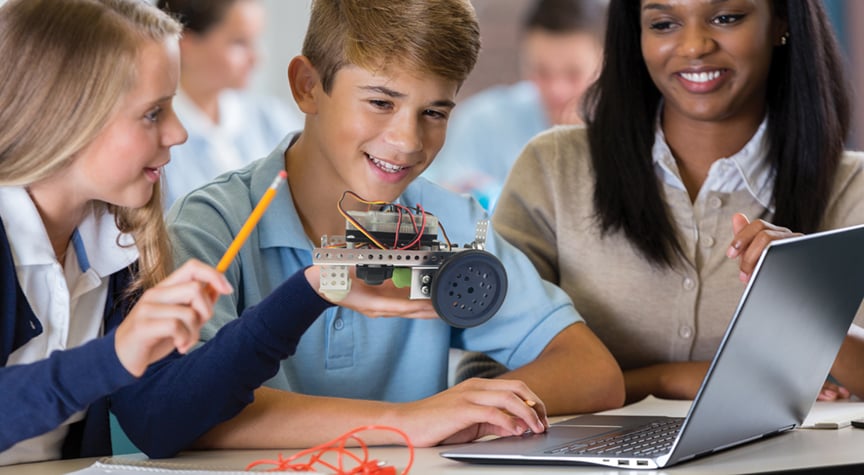
Robotics has become a popular activity for incorporating STEM in the classroom. Among other things, robots are engaging, eye-catching, dynamic, and more interesting than a book for capturing and holding a student’s attention. Unfortunately, the vast majority of classroom robots end up being little more than toys made to drive to and fro or side to side without really providing an opportunity for any scientific exploration and learning. When selecting robotic products to introduce in the classroom, it is important to look at the overall educational value of the system—particularly with regard to how it can be used to promote scientific exploration and learning together with the application of mathematic principles.
1. Not all robots have wheels.
The vast majority of robots at work in our world today are not vehicles, but automated manufacturing machines—conveyor belt systems that perform things like quality inspections and order fulfillment. Robots—or mechatronic systems, to be more accurate—include any system which integrates sensing devices with a computing platform and the ability to affect changes on the environment it is monitoring.
2. Does the system provide an opportunity to master STEM principles?
Another caution when selecting equipment and curricula to promote STEM education is to make sure that it provides an opportunity to actually use, master, and apply scientific and/or mathematic principles into the problem solving nature of the activities. Too often, a device which uses a processor and sensors will be offered for STEM education, but the students are limited to simply using the device without the opportunity to apply their knowledge to problem resolution. These limited systems may be inviting, but their educational value ends up being limited to observation and not engagement.
 A good example of a robotics system that promotes STEM education is the Mimio MyBot, especially when coupled with the Mars Exploration Bundle developed in conjunction with ShareSpace Education, a key program of the Aldrin Family Foundation. This bundle combines a powerful robotics control system with a rugged aluminum build system, a variety of different sensors and measurement devices, and a highly detailed floor-sized map of the planet Mars. Measuring over 600 square feet, the map is colorful, highly unique, and captures students’ attention. Using the map, lessons involving physics, geology, and geography become more engaging—even more so as the students start using the robots to explore and analyze the Martian surface.
A good example of a robotics system that promotes STEM education is the Mimio MyBot, especially when coupled with the Mars Exploration Bundle developed in conjunction with ShareSpace Education, a key program of the Aldrin Family Foundation. This bundle combines a powerful robotics control system with a rugged aluminum build system, a variety of different sensors and measurement devices, and a highly detailed floor-sized map of the planet Mars. Measuring over 600 square feet, the map is colorful, highly unique, and captures students’ attention. Using the map, lessons involving physics, geology, and geography become more engaging—even more so as the students start using the robots to explore and analyze the Martian surface.
3. What sensors are provided so you can expand the areas of study?
Below are some examples of sensors included with the Mimio MyBot system and how they can be used in STEM activities.
- High-resolution color sensors that can be used to explore the optical spectrum and experiment with the reflective, transmissive, and absorptive qualities of different materials.
- Three axis gyroscopes, which measure angular movement in each of the three axes and can be used to move along a fixed heading while monitoring side-to-side tilt and front-to-back pitch, enabling course correction should the robot begin to tip or approach a steep incline.
- Magnetic compass and three-axis accelerometer, which enables the robotic system to find magnetic north and can report changes in velocity in the different axes. In addition to motion exploration, this allows a demonstration of vectors and vector arithmetic.
- Optical and ultrasonic distance measurement for exploration of the speed of light and sound, as well as the ability to sense objects in the robot’s path for automatic collision avoidance.
- Infrared light detection and location, which expands on light and color experimentation by moving into the non-visible part of the spectrum.
- Ambient light sensors to explore physical phenomena regarding light, including coherency and loss over distance due to areal diffusion. They can also be used to record light levels over time using the MyBot’s built-in data-logging capabilities. Data from any of the sensors can be recorded periodically over the course of days and made available to spreadsheet programs for analysis and graphing.
- Magnetic field sensors to locate and measure magnetic fields, providing a hidden target for an autonomous robot hide-and-seek game.
These small, ruggedly packaged and pre-wired sensor modules allow students to observe real-world physical phenomena in a cost-effective and fun way, enabling educators to base lessons on more than just whiteboard drawings. With Mimio MyBot, you can bring science to life.
Our world today is increasingly dependent on technology, and the future workforce will embrace candidates who have the ability to not just use STEM products, but who have developed true STEM skills: the ability to apply their knowledge of science, mathematics, and technology to solve new problems. This new generation of skilled workers will have the ability to develop new and better technology solutions to solve tomorrow’s problems.
As the saying goes, “If the robots are going to take over your job, maybe you ought to be learning to control and program the robots.”
Want to learn more about incorporating robotics in the classroom? Visit the MyBot information page to discover how our intuitive system helps students develop core STEM skills.



